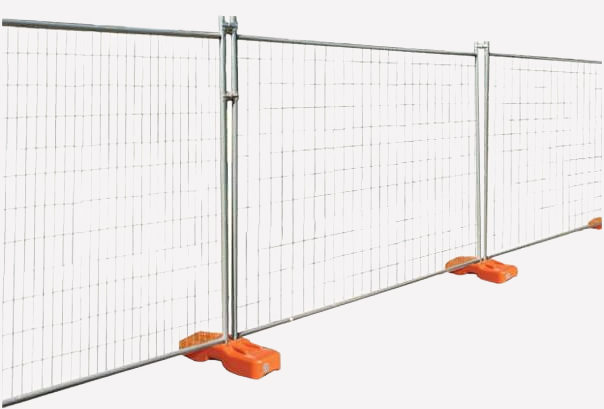Types of fencing and barriers

Temporary fencing and site barriers are used across all types of infrastructure, construction and building sites. Both fencing and barriers can have a multitude of uses to keep employees and the public safe and out of harm's way when construction or demolition work is taking place.
Some types of temporary fencing and barriers also have an added safety benefit, such as concrete barriers which can be used to stop vehicular entry, and temporary fencing panels which can be locked to keep worksites secure.
Both fencing and barriers are available in different types of sizes for different applications.
Types of temporary fencing
Temporary site fencing
Temporary site fencing panels are strong, durable, lightweight and easy to install.
Made from steel mesh with an anti-climb design, temporary fencing panels are used on construction sites, for setting up lockable and secure site perimeters, for enclosing hazards such as open pits, and for all different types of civil and infrastructure works.
Easy to set up and pack down, each panel can be combined with bracing, fence feet clamps, handrails, gates and other accessories to create a customised perimeter fence for your site. Each panel is 2.1m high x 2.4m long and panels are fast and easy to erect with just one person.
Edge Protection barriers
Edge protection barriers are special fixed panels that are bolted to the edge of a surface to provide safety during the construction process. They are typically used in applications such as on a concrete slab on a multi-deck building site, or around voids in a multi-storey construction project.
Made from rigid steel they include a bottom kick plate to stop tools or small personal items from being lost underneath the fence and potentially causing a safety hazard for workers below.
This type of temporary edge fencing creates a strong protective edge barrier around voids, drop-offs, edges and other hazardous areas. It can also be installed around excavations at ground level or as part of a larger scaffolding system (Jaybro supplies the Fortress Fencing XT Edge Protection Panels which comply with AS/NZS 4994.1:2009).
Crowd Control barriers
Temporary crowd control barriers are ideal for a range of pedestrian or non-traffic rated applications. The lightweight steel is available galvanised for corrosion protection or in orange painted steel for high visibility.
Each panel of crowd control fencing is low profile, meaning the fence can be erected in tight spaces or narrow corridors without extending out into the walkway zone and causing a safety issue for pedestrians.
With removable steel low-profile feet, these easy to set up barriers are designed for quick and easy deployment and pack up. This means they can easily be moved around your site as the project changes.
Tough and long-lasting, they are rugged and rust-resistant and can withstand outdoor life on construction and building sites. However, they are also great for use indoors, for example, if renovations are being carried out in part of a shopping centre. These barriers look neat and tidy and ensure pedestrians stay away from potentially dangerous work sites.
Types of construction site barriers
Concrete crash barriers
Concrete barriers are very tough and strong and are designed to reduce the severity of head-on traffic accidents. Manufactured with a steel bar running through the middle of the concrete, the barriers have extra strength and rigidity to keep them in place.
They are designed with a specific shape and profile which causes a car to be redirected into the flow of traffic rather than vaulting the barrier and causing a catastrophic accident.
Concrete crash barriers are usually used on temporary work sites to protect workers by providing a safety zone between them and fast-moving traffic. They can also be used in non-traffic applications, for example on a construction site, where they can protect staff parking areas from being hit by earthmoving equipment, or create safe channels to separate large equipment from workers.
Roadside concrete safety barriers are also known as jersey barriers or crash barriers, and they are heavily tested and given a MASH TL-3 rating making them suitable for use on most Australian highways.
Water filled barriers
Water filled crash barriers are available in all types of shapes and sizes and are used for both traffic and non-traffic applications
Ranging from lightweight blow-moulded plastic pedestrian barriers to more rigid and fully tested & approved traffic barriers, water-filled barriers provide safety and protection on the worksite, are easier to install than concrete barriers, and can be easily shifted around the site as circumstances change. They are also cost-effective and can be easily moved when empty, yet provide a strong and very heavy barrier when full of water. The average water filled barrier only weighs around 40kg empty making it extremely easy to get off a truck and install on-site without the use of a crane or the need for specialist barrier lifting attachments.
Once in place and filled with water, the plastic barriers can weigh up to 500 kg depending on the model.
Some water filled barriers are designed to handle impacts from cars travelling at speeds, such as the Lo-Ro barriers. Others are not crash rated but are still very useful for providing low impact worksite protection or being used as more of a visual barrier to control pedestrian traffic.
Both temporary fencing and barriers are an essential part of every worksite. Contact the team at Jaybro to find out more about our range or to get advice on choosing the right temporary fencing and barriers for your project.
 Sign In
Sign In 

